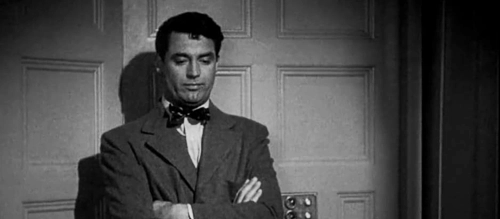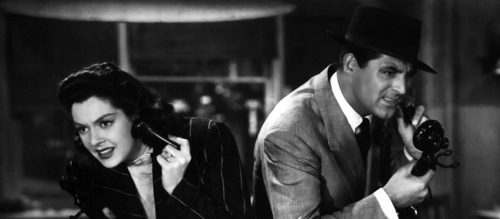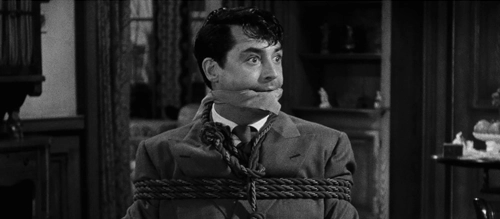Where to Start with Cary Grant
When Frank Sinatra presented Cary Grant with an honorary Academy Award in 1970 for a lifetime of contributions to the movies, he said, “No one has done more things well, from light comedy to stern drama, and made it look easier.”
As Sinatra so succinctly put it, Cary Grant, born Archibald Alexander Leach, was a brilliant, versatile actor who, for over 30 years, was one of the most bankable and sought after leading men in Hollywood. He is consistently ranked as one of the greatest actors of the Golden Age of cinema, as well as one of the greatest movie stars of all time.
Grant got his start in entertainment as a vaudeville performer in the 1920s and then, after tolling away for nearly a decade in some rather unremarkable films for Paramount, starred in 1937’s The Awful Truth, which firmly established the onscreen persona he became known for. His screwball comedies, like Bringing up Baby and His Girl Friday, are among some of the greatest ever made. During World War II, Grant tried his hand at more serious, dramatic roles like that in Penny Serenade, for which he was nominated for an Academy Award. Starting in 1941 with Suspicion, the actor would go on to have a rich collaboration with acclaimed director Alfred Hitchcock.
Dubbed a “slapstick Prince Charming” in 1975 by the late film critic Pauline Kael, Grant is often described as classically handsome, debonair, and, with his signature transatlantic accent, effortlessly sophisticated. He was also a comedic genius and had a keen sense of his own body, understanding perfectly how to manipulate it for the camera. The roots of modern romantic comedies can be traced back to Grant’s work; his contributions to that genre alone are unparalleled. His marriage of heart and humor made Grant the object of desire and affection. As many critics have pointed out over the years, women wanted him and men wanted to be him.
Figuring out where to start with an actor like Cary Grant can be daunting. Like many classic film stars, his work is extensive. In the 1930s alone, Grant made between 4 and 5 pictures a year on average. While his filmography includes everything from romances and crime dramas to mysteries and thrillers, he is perhaps best known and loved for his comedies. Exploring the films that were his bread and butter is perhaps the best introduction to his work. In this list from The Film Magazine, we will present three movies that showcase the very best of what made Cary Grant such a brilliant comedic talent and why his characters were so easy to fall in love with. This is Where to Start with Cary Grant.
1. Holiday (1938)

In George Cukor’s Holiday, Cary Grant plays Johnny Castle, a working man who wants to live a simple life free of the influence of money. But then Johnny meets and falls in love with Julia Seton (Doris Nolan), the daughter of a wealthy banker, and is thrust into a world of marble staircases and black tie affairs. And then, of course, there’s Linda Seton, Julia’s younger sister, played by the absolutely heartbreaking and brilliant Katharine Hepburn, who wishes desperately to leave behind her wealth and privilege and encourages Johnny to pursue his dreams. Holiday is not just a movie about who you should be with, it’s about how that choice reflects who you truly are and what you stand for.
It wouldn’t be quite right to describe Grant as vulnerable in Holiday. He always has a way of reeling you in, but he keeps you at an arm’s length. Still, he is certainly much more earnest and naïve in this film than in the other entries on this list. He slips into this role seamlessly, no doubt influenced by the fact that he grew up dirt poor in Bristol, England. It is enduring to see him explain his plans of making enough money just to quit and take a holiday, to figure out why he’s working and what he stands for. His face lights up, his eyes sparkle, but that fire is easily extinguished by Julia and her father (Henry Kolker), who insist Johnny take a job as a banker and make an absurd amount of money.
Grant is always doing something with his hands. He fiddles with a pipe, grips the back of a chair. He does several impressive flips in the movie – casually, just because. When Linda stands on Johnny’s shoulders and flips with him, in perfect unison, it shows how in sync they are and what a better match they’d make than he and Julia. The comedy of Holiday is more subtle than in a lot of Grant movies, the pace slower, and the actor adapts well. His dynamic with Katharine Hepburn is breezy and it is no surprise that Linda falls in love with Johnny immediately. In Holiday, Grant represents freedom and, as usual, it’s impossible to not be on his side. He always gives us a good reason to choose him above anyone else, to want to blow up your life before him.
2. His Girl Friday (1940)

In Howard Hawks’ His Girl Friday, Hildy Johnson (Rosalind Russel) is a long-suffering journalist looking to get out of the newspaper business for good. She is all set to marry the soft-spoken and stable Bruce Baldwin (Ralph Ballamy), an insurance salesman and the kind of guy who carries an umbrella everywhere just in case it rains. Hildy is on the verge of a new life – away from sensation and spectacle. She is going to be a wife, and a mom, and live in the suburbs.
Enter Cary Grant, playing Hildy’s ex-husband, Walter Burns, editor of The Morning Post. He will be damned if he lets his ex-wife and former star reporter settle down as a housewife. He spends the entire film trying to sabotage Hildy’s impending marriage. Luckily for him, a jailbreak and the possibility of getting a front page story sends Hildy running back to reporting and straight into Walter’s arms.
Grant’s character is pushy and aggressive. He doesn’t think twice about getting Hildy’s fiance arrested three times. He’s a man who works too much, who would probably walk right over you if it meant getting a juicy scoop. Regardless, Grant’s charm is electric and exciting, and even though what he’s doing is unethical and wrong, you don’t care. You want him to succeed. You want him to get her back. In Grant’s hands, Walter is more enticing, more confident, and more alive than Bruce. Compared to Grant, Ralph Ballamy, who is also in The Awful Truth and thus has a track record of losing women to him, is too earnest and, for someone like Hildy, entirely too boring. He’s too soft spoken and speaks too slowly. Grant steamrolls right over him – talks circles around him. There is no competition for winning Hildy’s heart – it is over before it even begins. The fun is in watching Hildy begrudgingly come to accept that.
There is something incredibly sexy and alluring about Cary Grant’s onscreen presence, and His Girl Friday showcases it. He is not ruggedly masculine like Clark Gable or broody and dark like James Dean, but there is a dazzling danger lurking in his eyes – one which always seems to be winking at you. In the beginning of the film, Hildy comes to see Walter to tell him about her engagement. When she asks to sit down, Grant (who is already sitting) says, “There’s been a lamp burning in the window for you, honey, here,” and pats his knee for her to sit on his lap. She doesn’t, quipping back, “I jumped out of that window a long time ago.”
The thing is, she didn’t. We all know she didn’t. Hildy puts up a good fight, but it’s no use. She can’t quit Walter anymore than she can quit the newspaper business. Like Walter, it’s too exciting, too addictive. She oscillates between being furious with him for sabotaging her impending marriage and going out of her way to get him the best story. Cary Grant may have played an angel in The Bishop’s Wife, but in His Girl Friday he is the devil himself, tempting his ex-wife to give into the person she actually is, instead of trying to become someone else.
That’s the thrill of his movies, and of falling love with the characters he plays. They’re impossible to resist. You can fight it as much as you want, but we all know it’s only going to end one way. Their reunion is inevitable. In reality, Bruce is the better choice. But lucky for us, this is the movies, and in the movies it’s better to be handcuffed to Cary Grant than it is to spend your whole life wishing you were.
3. Arsenic and Old Lace (1944)

There is a moment in The Awful Truth when Cary Grant’s character Jerry Warriner crashes his ex-wife’s vocal recital. After bursting into the room, all eyes on him, he settles into a chair in the corner. He leans back, flips himself over and knocks over the side table. His arm stuck in the leg of the chair, Grant stands, looks up briefly, his hair a mess, tie crooked, and struggles hilariously to fix everything.
Now imagine him doing that for two hours straight.
In 1944’s Arsenic and Old Lace, directed by Frank Capra and based on the play of the same name, Grant plays Mortimer Brewster, a dramatic critic whose crusade against the institution of marriage is thwarted by the minster’s daughter, Elaine Harper (Priscilla Lane) whom he falls in love with and marries. But things take a turn for the insane when Mortimer goes to see his sweet, old, innocent aunts’ house in Brooklyn before preparing to leave for his honeymoon. You see, Aunt Abby (Josephine Hull) and Aunt Martha (Jean Adair) have a few skeletons in their window seat – literally. Not only in there is a dead body in the window seat, there are currently 12 graves in the cellar. Aunt Abby and Aunt Martha have been poisoning lonely old men who come looking for a room to rent out of some misguided notion to “end their suffering.” To make matters worse, Mortimer’s brother Teddy (John Alexander) thinks he’s President Roosevelt and his other brother Jonathan (Raymond Massey) is a serial murderer on the run with his alcoholic plastic surgeon, Dr. Einstein (Peter Lorre).
Arsenic and Old Lace is delightfully unhinged, and all of Cary Grant’s signature mannerisms and quirks are dialled up to 1,000. Grant’s charm and elegance are juxtaposed with the chaos around him and he very quickly unravels. Grant spends the majority of the film running around, knocking over chairs and sweating, his jet black oiled hair tussled in a messy curl down the middle of his forehead. It is endlessly entertaining to watch him try to make sense of the absurdity around him and it leads to some exaggerated physical comedy that borders on slapstick.
Take, for instance, the moment Grant finds the corpse in the window seat. After looking inside and doing a double take, he sits down, his legs spread. His black eyes are wide, eyebrows narrowed, mouth agape. The look of astonishment on his face is priceless, and the subtle way he cocks his head from side to side keeps the bit going.
Arsenic and Old Lace is a delightful detour for Grant. His performance is free of ego – he doesn’t mind making himself look ridiculous. There are certainly other films in which Grant’s physical comedy skills are put to good use, like in The Awful Truth, but nothing comes close to matching this farce. Instead of falling back on his newfound reputation of sophistication and charm, he fully embraces the wacky. It is interesting to note, however, that Grant was actually quite insecure about his performance at the time of filming – in David Cairnes’ essay for the Criterion edition of Arsenic and Old Lace, he writes that Grant’s comedy inspirations, like Stan Laurel and Harry Langdon, were “rarely frenetic, more like the still centers of slapstick chaos.” Cairnes continued, “One supposes that, having built up a reputation for suavity, the former Archibald Leach might have been disconcerted by the prospect of spending a whole movie in a state of perspiring panic.”
Grant’s insecurities do not show on screen. In fact, his humble feelings are actually a benefit to his screen presence. One of the reasons Arsenic and Old Lace is such a great place to start with him is because his performance is free of ego. It is unburdened. His unravelling doesn’t detract from his lovability – it only highlights it. There’s a reason Mortimer still gets the girl in the end – how could he not?
Recommended for you: 5 James Stewart Movies That Made Him a Star
In Holiday, when Linda tries to convince Julia and their father to trust Johnny and to love him as much as she does, she says, “Life walked into the house this morning.” That is the perfect way to describe Cary Grant in all of his movies. He is the one you gravitate to, the one you want to watch. Whether he’s acting like a lunatic, a jerk, or a relatable plain man of the people, Grant captures your heart. His onscreen persona was carefully curated, light and warm, the darkness of real-life rarely seeping through. The three films on this list represent only a fraction of his work, but it will hopefully open up a whole world of stories to explore.

